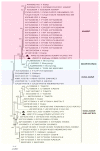Pathological Responses in Asian House Shrews (Suncus murinus) to the Naturally Acquired Orientia tsutsugamushi Infection
- PMID: 38674692
- PMCID: PMC11051718
- DOI: 10.3390/microorganisms12040748
Pathological Responses in Asian House Shrews (Suncus murinus) to the Naturally Acquired Orientia tsutsugamushi Infection
Abstract
Scrub typhus is a re-emerging disease caused by Orientia tsutsugamushi, transmitted by mites belonging to the family Trombiculidae. Humans and rodents acquire the infection by the bite of larval mites/chiggers. Suncus murinus, the Asian house shrew, has been reported to harbor the vector mites and has been naturally infected with O. tsutsugamushi. The present study aimed to localize and record O. tsutsugamushi in the tissues and the host response in shrews naturally infected with O. tsutsugamushi. Sheehan's modified May-Grunwald Giemsa staining was carried out in 365 tissues from 87 animals, and rickettsiae were documented in 87 tissues from 20 animals. Immunohistochemical (IHC) staining, using polyclonal antibodies raised against selected epitopes of the 56-kDa antigen, was carried out, and 81/87 tissue sections were tested positive for O. tsutsugamushi. By IHC, in addition to the endothelium, the pathogen was also demonstrated by IHC in cardiomyocytes, the bronchiolar epithelium, stroma of the lungs, hepatocytes, the bile duct epithelium, the epithelium and goblet cells of intestine, the tubular epithelium of the kidney, and splenic macrophages. Furthermore, the pathogen was confirmed by real-time PCR using blood (n = 20) and tissues (n = 81) of the IHC-positive animals. None of the blood samples and only 22 out of 81 IHC-positive tissues were tested positive by PCR. By nucleotide sequencing of the 56-kDa gene, Gilliam and Karp strains were found circulating among these animals. Although these bacterial strains are highly virulent and cause a wide range of pathological alterations, hence exploring their adaptive mechanisms of survival in shrews will be of significance. Given that the pathogen localizes in various organs following a transient bacteremia, we recommend the inclusion of tissues from the heart, lung, intestine, and kidney of reservoir animals, in addition to blood samples, for future molecular surveillance of scrub typhus.
Keywords: Orientia tsutsugamushi; Suncus murinus; histochemistry; immunohistochemistry; pathological responses; scrub typhus.
Conflict of interest statement
The authors declare no conflict of interest.
Figures







Similar articles
-
Occurrence of Orientia tsutsugamushi, the Etiological Agent of Scrub Typhus in Animal Hosts and Mite Vectors in Areas Reporting Human Cases of Acute Encephalitis Syndrome in the Gorakhpur Region of Uttar Pradesh, India.Vector Borne Zoonotic Dis. 2018 Oct;18(10):539-547. doi: 10.1089/vbz.2017.2246. Epub 2018 Jul 17. Vector Borne Zoonotic Dis. 2018. PMID: 30016222
-
Seasonal abundance of Leptotrombidium deliense, the vector of scrub typhus, in areas reporting acute encephalitis syndrome in Gorakhpur district, Uttar Pradesh, India.Exp Appl Acarol. 2021 Aug;84(4):795-808. doi: 10.1007/s10493-021-00650-2. Epub 2021 Jul 30. Exp Appl Acarol. 2021. PMID: 34328572
-
Abundance & distribution of trombiculid mites & Orientia tsutsugamushi, the vectors & pathogen of scrub typhus in rodents & shrews collected from Puducherry & Tamil Nadu, India.Indian J Med Res. 2016 Dec;144(6):893-900. doi: 10.4103/ijmr.IJMR_1390_15. Indian J Med Res. 2016. PMID: 28474626 Free PMC article.
-
A Review of Scrub Typhus (Orientia tsutsugamushi and Related Organisms): Then, Now, and Tomorrow.Trop Med Infect Dis. 2018 Jan 17;3(1):8. doi: 10.3390/tropicalmed3010008. Trop Med Infect Dis. 2018. PMID: 30274407 Free PMC article. Review.
-
Scrub typhus ecology: a systematic review of Orientia in vectors and hosts.Parasit Vectors. 2019 Nov 4;12(1):513. doi: 10.1186/s13071-019-3751-x. Parasit Vectors. 2019. PMID: 31685019 Free PMC article.
Cited by
-
Synanthropic rodents and shrews are reservoirs of zoonotic bacterial pathogens and act as sentinels for antimicrobial resistance spillover in the environment: A study from Puducherry, India.One Health. 2024 May 17;18:100759. doi: 10.1016/j.onehlt.2024.100759. eCollection 2024 Jun. One Health. 2024. PMID: 38784598 Free PMC article.
References
-
- Candasamy S., Ayyanar E., Paily K., Karthikeyan P.A., Sundararajan A., Purushothaman J. Abundance & distribution of trombiculid mites and Orientia tsutsugamushi, the vectors & pathogen of scrub typhus in rodents and shrews collected from Puducherry and Tamil Nadu India. Indian J. Med. Res. 2016;144:893–900. - PMC - PubMed
-
- Devaraju P., Arumugam B., Mohan I., Paraman M., Ashokkumar M., Kasinathan G., Purushothaman J. Evidence of natural infection of Orientia tsutsugamushi in vectors and animal hosts—Risk of scrub typhus transmission to humans in Puducherry, South India. Indian J. Public Health. 2020;64:27–31. doi: 10.4103/ijph.IJPH_130_19. - DOI - PubMed
-
- Walsh D.S., Delacruz E.C., Abalos R.M., Tan E.V., Jiang J., Richards A.L., Eamsila C., Rodkvantook W., Myint K.S.A. Clinical and histological features of inoculation site skin lesions in cynomolgus monkeys experimentally infected with Orientia tsutsugamushi. Vector Borne Zoonotic Dis. 2007;7:547–554. doi: 10.1089/vbz.2006.0642. - DOI - PubMed
Grants and funding
LinkOut - more resources
Full Text Sources

